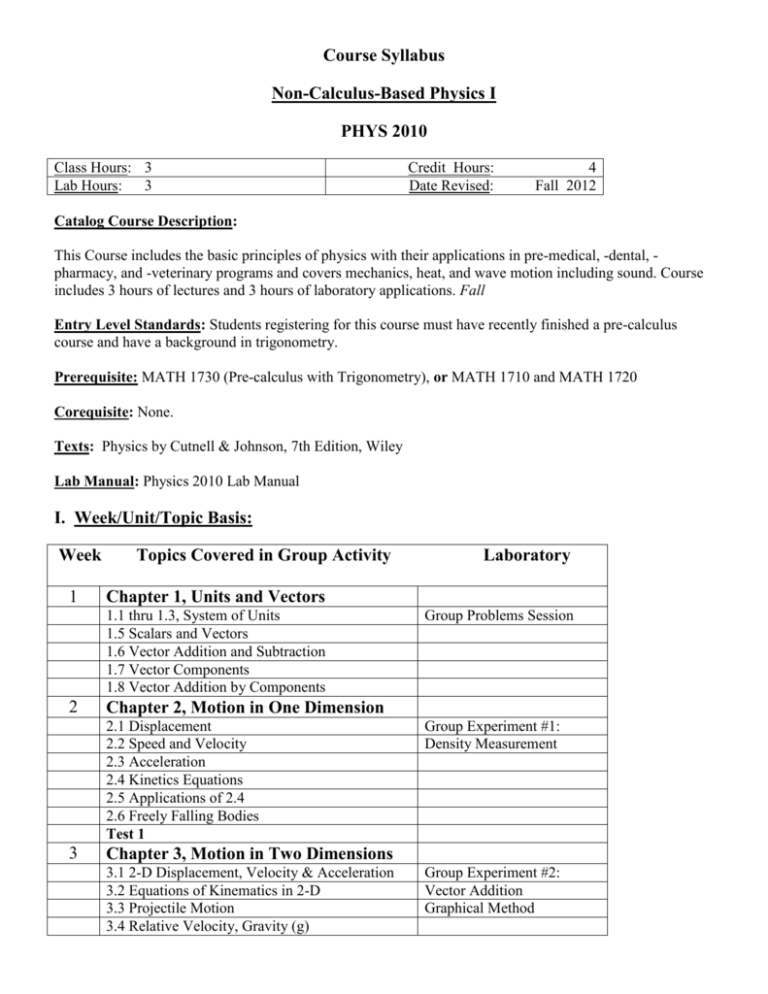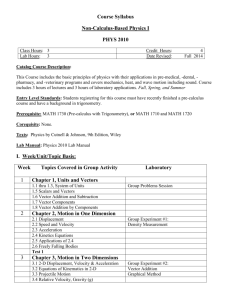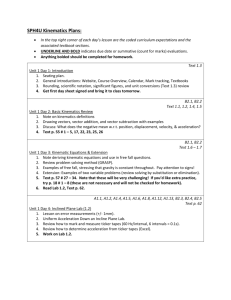Course Syllabus
advertisement

Course Syllabus Non-Calculus-Based Physics I PHYS 2010 Class Hours: 3 Lab Hours: 3 Credit Hours: Date Revised: 4 Fall 2012 Catalog Course Description: This Course includes the basic principles of physics with their applications in pre-medical, -dental, pharmacy, and -veterinary programs and covers mechanics, heat, and wave motion including sound. Course includes 3 hours of lectures and 3 hours of laboratory applications. Fall Entry Level Standards: Students registering for this course must have recently finished a pre-calculus course and have a background in trigonometry. Prerequisite: MATH 1730 (Pre-calculus with Trigonometry), or MATH 1710 and MATH 1720 Corequisite: None. Texts: Physics by Cutnell & Johnson, 7th Edition, Wiley Lab Manual: Physics 2010 Lab Manual I. Week/Unit/Topic Basis: Week 1 Topics Covered in Group Activity Chapter 1, Units and Vectors 1.1 thru 1.3, System of Units 1.5 Scalars and Vectors 1.6 Vector Addition and Subtraction 1.7 Vector Components 1.8 Vector Addition by Components 2 Group Problems Session Chapter 2, Motion in One Dimension 2.1 Displacement 2.2 Speed and Velocity 2.3 Acceleration 2.4 Kinetics Equations 2.5 Applications of 2.4 2.6 Freely Falling Bodies Test 1 3 Laboratory Group Experiment #1: Density Measurement Chapter 3, Motion in Two Dimensions 3.1 2-D Displacement, Velocity & Acceleration 3.2 Equations of Kinematics in 2-D 3.3 Projectile Motion 3.4 Relative Velocity, Gravity (g) Group Experiment #2: Vector Addition Graphical Method 4 Chapter 4, Force and Motion 4.1 The Concept of Force and Mass 4.2 Newton's 1st Law of Motion 4.3 Newton's 2nd Law of Motion Force Table 4.4 The Vector Nature of 2nd Law 4.5 Newton's 3rd Law of Motion Test 2 5 Chapter 4, continued… 4.7 and 4.8: The Gravity & Normal Forces 4.9 Frictional Force 4.10 The Tension Force 4.11 and 4.12: Equilibrium of Forces 6 Group Experiment #6: Newton’s Second Law Chapter 7, Impulse and Momentum 7.1 The Impulse-Momentum Theorem 7.2 Conservation of Linear Momentum 7.3 Collision in One Dimension Test 4 9 Group Experiment #5: Coefficient of Friction Chapter 6, Work and Energy 6.1 Work Done by a Constant Force 6.2 The Work-Energy Theorem and K.E 6.3 Gravitational Potential Energy 6.4 - 6.5 Conservation of Mechanical Energy 6.6 Work-Kinetic Energy Theorem 6.7 Power 6.9 Work done by a variable force 8 Group Experiment #4: Measurement of "g", The Acceleration of Gravity Chapter 5, Uniform Circular Motion 5.1 Uniform Circular Motion 5.2 Centripetal Acceleration 5.3 Centripetal Force 5.4 Banked Curves 5.5 Satellites in Circular Orbits 5.6 Vertical Circular Motion Test 3 7 Group Experiment #3: Vector Addition Equilibrium of Concurrent Forces (The Force Table) Group Experiment #7: Conservation of Energy Chapter 8, Rotational Kinematics 8.1 Angular Displacement 8.2 Angular Velocity and Acceleration 8.3 Rotational Kinematics 8.4 Angular and Tangential Variables 8.5 Centripetal and Tangential Acceleration Group Experiment #8: Centripetal Force Chapter 9, Rotational Kinetics 9.1 Torque Concept 9.2 Rigid Objects in Equilibrium 10 Chapter 9, Rotational Kinetics 9.3 Center of Gravity 9.4 Newton’s 2nd Law for Rotation about an Axis 9.5 Rotational Work and Energy Ch. 9 Problems Session Ch. 10 Problems Session Chapter 10, Simple Harmonic Motion 10.1 Ideal Springs and Simple Harmonic Motion 10.2 Simple Harmonic Motion - Reference Circle Test 5 11 Chapter 11, Pressure and Fluids 11.1 Mass Density 11.2 Pressure 11.3 Pressure and Depth in Static Fluids 11.5 Pascal's Principle 11.6 Archimedes' Principle 12 Chapter 12, Temperature and Heat 12.1-3 Temp. Scales & Thermometers 12.4-5 Thermal Expansion 12.6 Heat and Internal Energy 12.7 Heat and Temperature Change 12.8 Heat and Phase Change Test 6 13 Group Experiment 10: Specific Heat Measurement Chapter 16, Waves 16.1 The Nature of Waves 16.2 Periodic Waves 16.3 The Speed of a Wave on a String 16.4 Equation of a Wave 16.5 The Nature of Sound 16.6 The Speed of Sound 16.9 The Doppler Effect 15 Group Experiment #9 Archimedes' Principle, Specific Gravity Chapter 14, Expansion of Gases 14.1 The Mole Concept & Avogadro's Number 14.2 The Ideal Gas Law 14 Ch. 11 Problems Session Group Experiment 11: Speed of Sound (Air Column Resonance) Final Exam Period Extended Closure: If for any reason the college has to close for any number of days, it is your responsibility to study and follow the syllabus as if you are attending classes. You should frequently check your email and follow the instructions given by your instructor as how and when tests will be given. For laboratory experiments, our existing physics applets on our NBS Website will be used. You will perform online experiments and email your reports. Clicks to get to Chapters: At www.pstcc.edu - Academics - Academic Departments - Natural and Behavioral Sciences - Physics - On the line for PHYS 2010 you may click on Chapters, Syllabus, Experim., etc….. II. Course Objectives: The objective of this course is to familiarize students with the principles of physics as the basis for their continuation of studies in Science and Medical profession. At work sites, the graduates often need to work with devices that operate by virtue of physics principles. Examples are traction equipment, X-ray machines, sonogram, blood pressure measurement devices, etc. The examples and problems selected for the course give the students the necessary knowledge and skills to read and analyze scientific data with proper understanding of the units involved and the types of physical quantities measured. The first few chapters lay down the foundation that is absolutely necessary to the understanding of physical quantities that appear in later chapters and are often seen on equipment used in medicine or industry. On this basis, after finishing this course, students will be able to: A. B. C. D. E. F. G. H. I. J. K. L. M. N. O. explain Metric and American units and systems and perform various conversions between the two, (The gauges at work sites often use both types of units), (V.1 & V.3) Describe the motion of a body and calculate the necessary parameters by using equations of motion in a practical situation, (V.1 & V.4) resolve a vector into its rectangular components, (V.3) Analyze force-motion relations in a practical situation, (V.1 & V.4) calculate the work done by a force as well as energy calculations and conversion to heat (calories),(V.1 & V.4) explain different forms of energy and their conversion to each other as well as the Principle of Conservation of Energy, (V.1, V.2, V.3,& V.4) apply the laws of conservation of energy and momentum, (V.2, V.3,& V.4) calculate the parameters involved in the motion of a rotating object such as particle separators (centrifugal separating devices),(V.2 & V.4) apply the laws of fluid pressure and density to measure the necessary parameters in a practical situation at work, (V.1 & V.3) make temperature measurements in different scales and convert and use them for heat and energy calculations with or without phase change, (V.3) apply the equations for thermal expansion of solids, liquids, and gases, (V.3) Describe oscillatory motion by measuring wavelength, amplitude, and the phase of motion of mechanical waves such as sound, (V.1 & V.3) apply the knowledge of sound parameters such as frequency, wavelength, and in interpreting the signals on measurement devices in sonogram and ultrasound, (V.3) apply the conditions of static equilibrium to find the forces acting on an object in a given situation, (V.1 & V.3) and use the concept of torque of a force to analyze the static equilibrium of a rigid body. (V.3) III. Instructional Processes: Students will: 1 2 3 4 5 6 7 8 learn in a cooperative mode by working in small groups with other students and exchanging ideas within each group (or sometimes collectively) while being coached by the instructor who provides assistance when needed, (Active Learning Strategy), learn by being a problem solver rather than being lectured, (Active Learning Strategy), explore and seek the solutions to the given problems that measures his/her level of accomplishment, (Active Learning Strategy), visit industry sites or will be visited by a person from industry who applies the concepts being learned at his/her work site, (Transitional Strategy), gradually be given higher- and higher-level problems to promote his/her critical thinking ability, (Active Learning Strategy), search for the solution to the assigned projects by examining the available software and resources. (Transitional Strategy), get engaged in learning processes such as projects, mentoring, apprenticeships, and/or research activities as time allows, (Transitional Strategy), and use computers with appropriate software during class or lab as a boost to the learning process (Technology Literacy Outcome). IV. Expectations for Student Performance:* Upon successful completion of this course, the student should be able to: 1 2 3 4 5 6 7 8 9 10 11 12 13 14 15 16 * apply the physics concepts to theoretical and practical situations (A through K), estimate an unknown parameter in a given practical situation by using the physics principles involved, (B, D, E, F, G, H, and I), recognize and identify the use of equipment and machines from the units used in their gauges, (A), master energy calculations to estimate energy requirement and feasibility in a given situation, (D, E, and F), perform necessary conversion between Metric and non-metric units and systems (A), apply the kinematics equations to describe motion, (B and C), apply the kinetics equation in force-motion situations (B and C), calculate the work done, energy involved, and energy conversions in a given problem (D, E, and F), solve problems involving circular motion as well as torque, energy, and momentum calculations (E, F, and G), solve temperature and heat problems with or without phase changes, (I), solve problems involving heat effect and thermal expansion in solids, fluids, and gases (J), solve problems in oscillatory motion in order to find the parameters involved (K and L), solve and analyze fluid pressure, air pressure, and density problems (H), apply a vector approach where vector quantities are involved (M), resolve a vector into two components graphically and analytically (M), and apply force and torque equilibrium concepts in solving rigid-body problems (M, N, and O). Letters after performance expectations reference the course objectives listed above. V. Evaluation: Students are primarily evaluated on the basis of test/quiz type assessments and homework as outlined on the syllabus and supplement distributed by the instructor. The following formula is used to evaluate the course grade: A Course Grade = (0.75)x(Theory Grade) + (0.25)x(Lab Grade) For Campus-based Students: Theory Grade = 0.80(Tests+Quizzes + H.W. ) + 0.20(Comprehensive. Final) B Tests count (80%), quizzes (10%), and homework (10%). The number of tests may vary from 5 to 7. The percentages given for tests, quizzes, and homework may vary depending on the instructor. For Online Students:Theory Grade = 0.70( Tests Mean ) + 0.30(Comprehensive In-class Final) There will be an online chapter test each week. Final Exam must be taken on campus. Laboratory Grade = (the sum of reports grades) / (the number of the reports). C D E 11 experiments* are designed for the course. Each experiment requires a report that must be at least spellchecked. Procedures for a standard lab report will be given by your instructor. To avoid a ZERO Laboratory Grade, at least 6 reports must be turned in. No late lab report(s) will be accepted and there are No Lab Make-ups. Site Visits: The necessary site visits will be announced as the arrangements are made. Evaluation will be based on of attendance as well as the visit report. Grading Scale: (91-100: A), (87-91: B+), ( 81-87 : B), (77-81: C+), (70-77:C), and (60-70: D) VI. Policies: Attendance: College Policy mandates that a student be present for at least 75% of the scheduled class and lab meetings in order to receive credit for the course. Lab Reports: No late lab report will be accepted and there are No Lab Make-ups. Students with Disabilities: If you need accommodations because of a disability, if you have emergency medical information to share, or if you need special arrangements in case the building must be evacuated, please inform me immediately. Please see me privately after class or in my office. Students must present a current accommodation plan from a staff member in Services for Students with Disabilities (SSWD)in order to receive accommodations in this course. Services for Students with Disabilities may be contacted by going to Goins 125, 127 or 131,or Alexander 105 or by phone: 694-6751(Voice/TDY), 539-7153, 539-7091 or 539-7249. Experiments: 1 Measurement and Density 2 Addition of Vectors (Graphical Approach) 3 Addition of Vectors ( Force Table) 4 Measurement of "g", The Acceleration of Gravity 5 Coefficient of Friction 6 Newton’s Second Law 7 Conservation of Energy 8 Centripetal Force 9 Archimedes' Principle 10 Specific Heat Measurement 11 Speed of Sound








